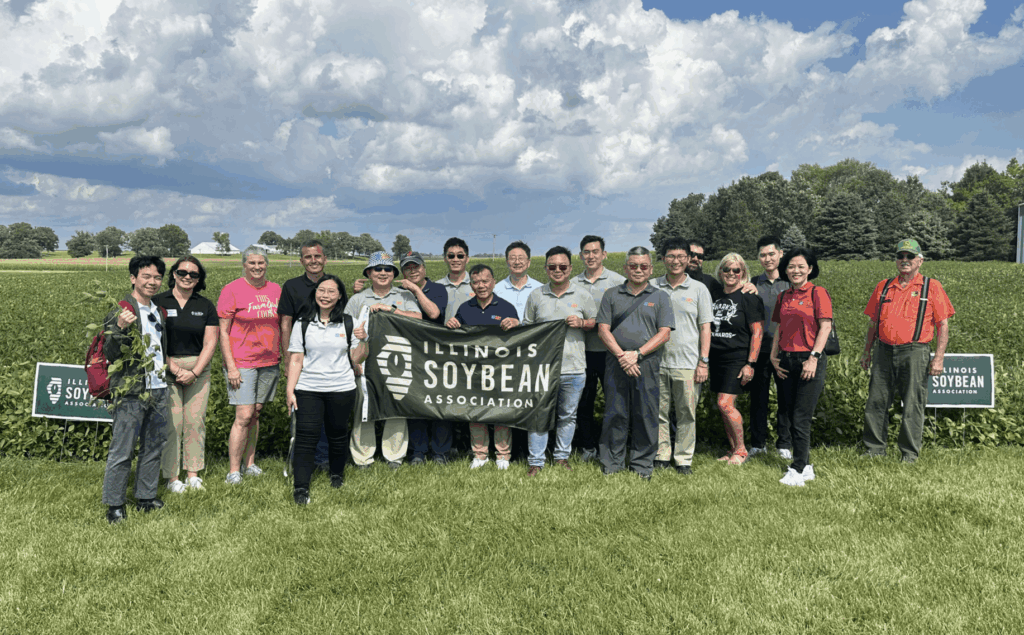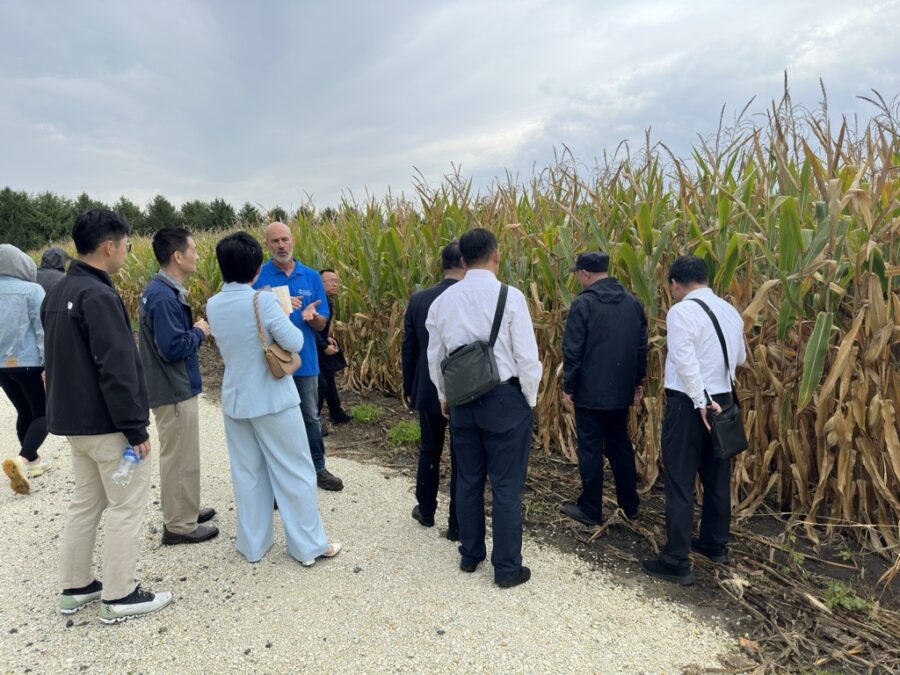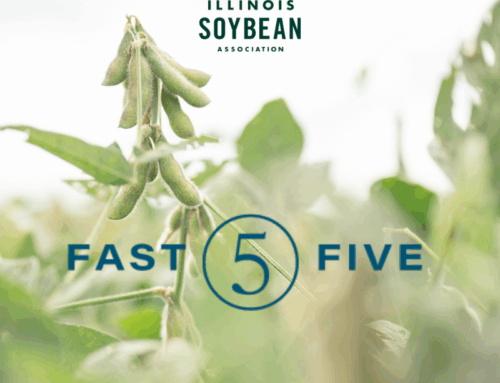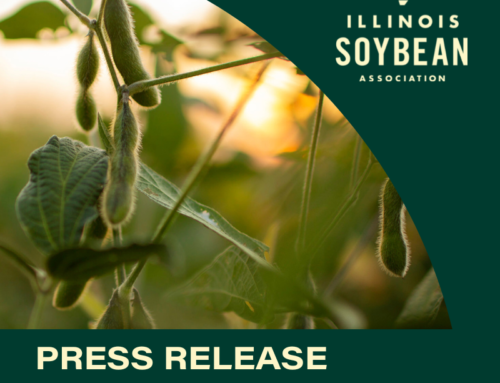Have you ever wondered what a trade visit with the Illinois Soybean Association (ISA) is like, who attends and what they accomplish? Find a list of frequently asked questions below to see what soybean buyers want to know when they visit Illinois soybean farms.
It is essential to note that there is a wide variety of answers to these questions, as the 43,000 Illinois soybean farms vary in type and location. Another layer of nuance stems from the diversity of visitors. While some come to the U.S. to dive deeper into their particular field, others visit simply for discovery as they step into a soybean field for the first time.

What is the average yield?
Yields vary across the state due to soil type, weather patterns and farming practices. State-wide, Illinois averages 64 bushels per acre, and in 2024, farmers harvested a record-breaking 688 million bushels.
What are the differences between GMO and non-GMO soybeans?
Conventional soybeans are developed through traditional breeding methods with no genetic engineering. GMO soybeans have had their DNA altered in a lab to introduce traits such as herbicide resistance, pest resistance, improved yield or drought resistance.
What inputs go into soybean production?
This list will depend upon each farmer and field conditions, but some examples of inputs for soybean production are labor, farm management expenditures, land cost, soil preparation, fertilizer, lime, herbicides, insecticides, fungicides and seed costs. In some cases, irrigation systems are also an expense for some Illinois farms.
What technology is being used on a farm?
Tractors include GPS navigation, AI and machine learning and obstacle detection sensors. They can also be equipped with telematics systems for real-time monitoring, cloud-based platforms to sync with farm management software, and remote diagnostics to detect and fix issues. Tractors can be integrated with auto-steering systems for accurate row spacing, soil and crop sensors to monitor the field, and variable rate technology (VRT) to adjust inputs in real-time. Some farmers also utilize drones and satellite imagery to help assess field conditions and make data-driven decisions about fertilization and pest control. The latest advances in seed technology and sustainable crop development allow farmers to increase yield while reducing environmental impact.
Where do farmers sell their soybeans?
Local elevators, soy processing facilities and exporters are all major destinations for Illinois soybeans. Illinois is unique with its robust transportation system that offers farmers a variety of options for marketing their soybeans throughout the year. Positioned on the Mississippi River, Ohio River and Lake Michigan, in addition to a variety of internal river, rail and roadway systems, Illinois farmers export 60% of their soybean harvest. However, to get there, farmers market their soybeans in different ways, ranging from futures contracts to spot sales at small, medium and large facilities.
How do you store soybeans?
Soybeans will be stored in grain bins either on a farm, at a local elevator or at a processing facility. Once harvested, soybeans maintain their moisture level, and with the plants naturally drying in the field, they do not need any additional heat drying once in storage.
How many people work on a farm?
Ranging from one acre to thousands, Illinois farms require various levels of time and energy to maintain. Despite their differences, 96% of Illinois farms are family-owned and operated, all with a commitment to the land they live on. As a family operation, oftentimes generations work side-by-side either as their full-time jobs or in addition to a career off the farm. Owner-operators, full-time and several part-time or seasonal workers might be required to keep the farm running smoothly. Farmers also work with input suppliers, equipment dealers, agronomists or consultants, grain elevators or processors, transportation services, and financial or crop insurance providers to help with their farm business.
How long is the planting or harvesting season?
Row crop farming is weather-dependent for planting, growing and harvesting seasons. Farmers typically plant soybeans in the spring as soon as the temperature begins to rise, and they can avoid major risks of frost. From April to May, farmers race against the weather to get soybeans in the ground as early as possible to give the plants the most opportunity for warm, sunny weather.
Additionally, some farmers incorporate winter wheat into their crop rotation. Wheat is harvested in July, which allows the farmer to take advantage of a late soybean planting season for double-cropping.
In Illinois, our climate naturally allows soybeans to dry down in the field before harvest for ideal moisture levels and quality. Once the weather begins to cool in late September, the plants will turn brown and lose their leaves. Farmers will then check their fields to determine moisture levels, and once they reach a threshold below 14%, harvest begins. This can range anywhere from September to November, depending on farm size and weather patterns.
What does the growing season look like for farmers?
Before the first soybean can be planted in the ground, planning for the next season begins long beforehand. A typical Illinois farmer grows corn, soybeans and sometimes wheat or livestock. Farmers may start the growing season off in the spring with soil preparation, applying fertilizer and herbicides to prepare for planting. In a normal year, many Illinois farmers start to plant in April, depending on the temperature and moisture. Farmers depend upon weather forecasts to guide planting decisions. Overall, crop growth and development occur during the summer (June – August). Farmers scout fields for pests, diseases, weeds and apply pesticides if needed at critical crop developmental stages. Harvest takes place in the fall (September – November). After crops are harvested, some farmers may do soil preparation, fall herbicide applications, plant cover crops, take soil samples or apply fertilizer. In the winter months, farmers repair and maintain machinery, make seed and other input decisions, and most importantly, do financial planning.
How is price established?
Soybean prices are established through a combination of global markets, local supply and demand, and futures trading (Chicago Board of Trade or CBOT). Weather, crop conditions, local basis, currency exchange rates, and government policies and reports have an impact or move markets.
In the last 20 years, prices have changed drastically. From the 2000-2004 average of $6.15/bushel to the 2020-2024 average at $12.71/bushel, farmers see the financial benefit of growing soybeans. However, non-land costs have also increased, with one farmer mentioning a 400% spike in productivity and pricing in this timeframe. With increased soybean prices come increased expenses.
What contributes to the quality of soybeans?
Moisture
- Moisture levels below 14% ensure the quality of soybeans in storage by reducing the risk of mold
Level of foreign matter
- U.S. soybeans contain less foreign matter than soybeans of other origins
Amino acid profile
- In certain regions, heat treatment is necessary, but it can also reduce amino acid digestibility. In the U.S., soybeans are not heat-treated due to ideal growing conditions
- Higher amino acid digestibility will reduce the need for synthetic amino acid supplementation in swine and poultry diets, which reduces formulation costs
Digestibility
- This difference in digestibility is important as the inclusion of soybean meal with higher amino acid digestibility results in fewer undigested amino acids being excreted. This minimizes the nitrogen output, which supports sustainablity.
Consistency
- Minimizing variability results in better business performance with less need to adjust diet formulations.
Oil content
- Check out this website to learn more about the different soybean varieties and their uses: Home – Specialty U.S. Soy Database
Sustainability
- U.S. soy has the lowest carbon footprint compared to soy of other origins
- Since 1980, U.S. soy farmers have:
- Reduced greenhouse gas (GHG) emissions per bushel by 42%
- Improved irrigation water use efficiency by 61%
- Increased land use efficiency by 47%
- Improved energy use efficiency by 45%
- Improved soil conservation by 35%
- Increased soy production by 130%

ISA At-Large Director Jeff O’Connor is one farmer who has played a vital role in hosting many trade teams during his time on the board.
He accounts, “I have now had 20+ groups visit the farm in the last ten years. I feel most impactful when I have a conversation with the individuals rather than when I gave speeches early on. I ensure that I am providing them what they want in their terms, such as metric equivalents, not English terminology. Stressing that this is truly a family operation that cares for each field through conservation and sustainable practices.”
He also credits his wife Gina for the role she plays in hosting groups by engaging through side conversations on topics that many individuals are also truly interested in: family, health and food.
Interested in visiting an Illinois farm? Visit this link to connect with ISA staff!

